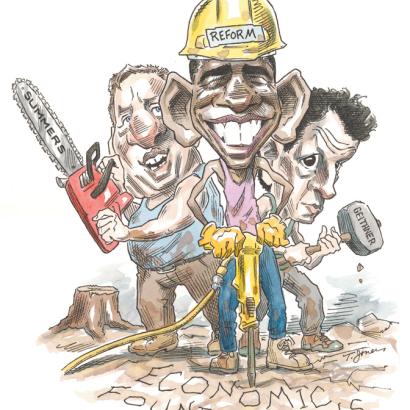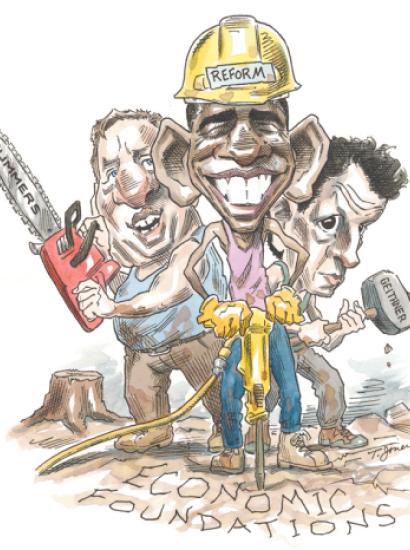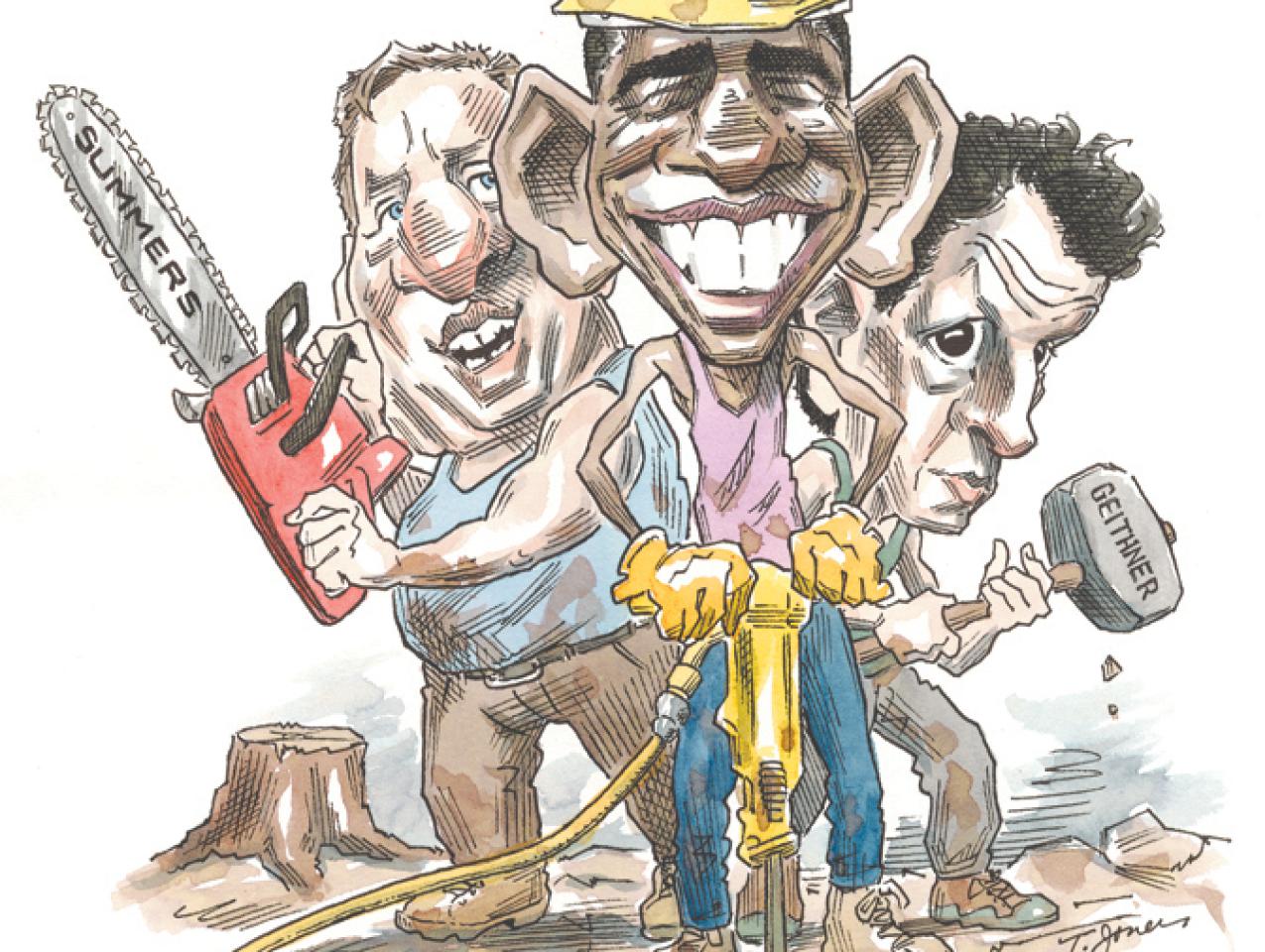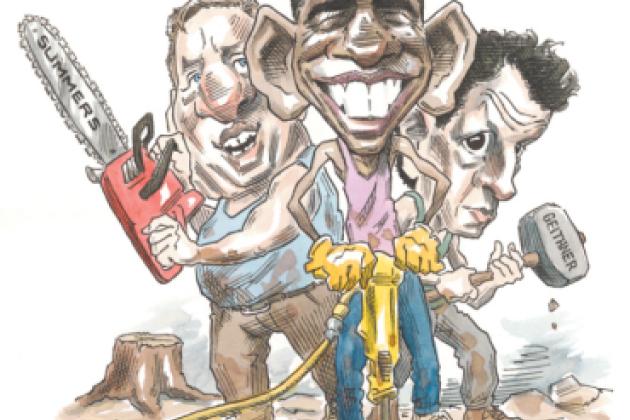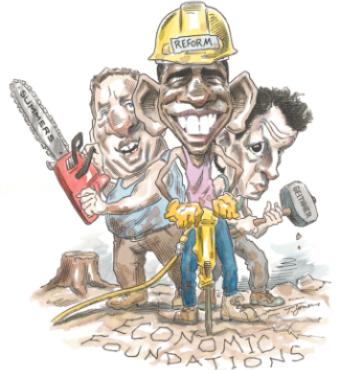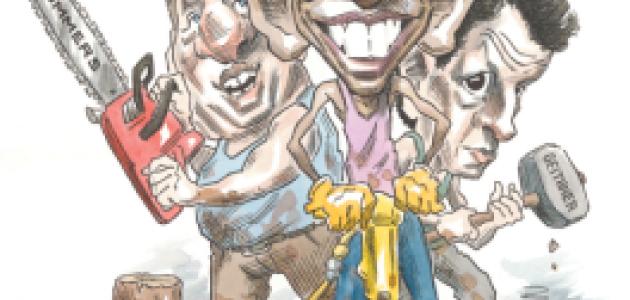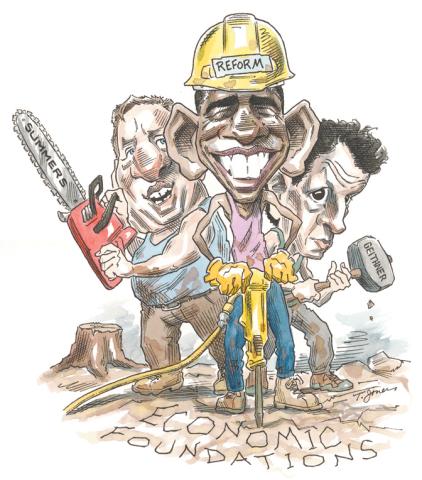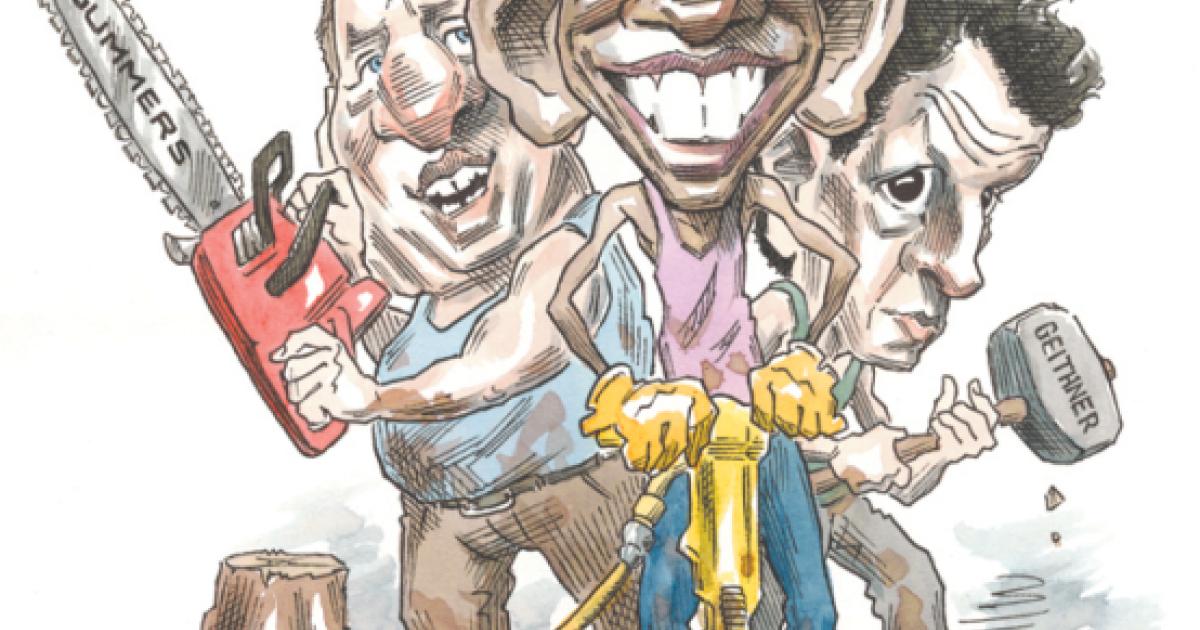- Budget & Spending
- US Labor Market
- Economics
- Law & Policy
- Regulation & Property Rights
- Monetary Policy
- Politics, Institutions, and Public Opinion
- Health Care
In terms of U.S. output contractions, the so-called Great Recession was not much more severe than the recessions of 1973–75 and 1981–82. Yet recovery from the latest recession started out much more slowly. For example, real gross domestic product expanded by 7.7 percent in 1983 after unemployment peaked at 10.8 percent in December 1982, whereas GDP grew at an unimpressive annual rate of 2.2 percent in the third quarter of 2009. Although the fourth quarter showed much better numbers—5.7 percent—there are still no signs of an explosive takeoff from the recession.
We believe that two factors explain this tepid rebound. One is obvious: the severe financial crisis that precipitated this recession, with many major financial institutions receiving large bailouts from the federal government. The confidence of bankers and venture capitalists has been shattered, at least for a while, and it will take time for them to recover from the financial turmoil of the past couple of years. The household sector also faces a difficult period of financial retrenchment in the wake of a major collapse in home prices, overextended debt positions for many, and high unemployment.
The second factor is less obvious, but possibly also of great importance. Liberal Democrats won a major victory in the 2008 elections, winning the presidency and large majorities in both the House and Senate. They interpreted this as evidence that a large majority of Americans want major reforms in the economy, health care, and many other areas. So in addition to continuing and extending the Bush-initiated bailout of banks, AIG, General Motors, Chrysler, and other companies, Congress and President Obama signaled their intentions to introduce major changes in taxes, government spending, and regulations—changes that could radically transform the American economy.
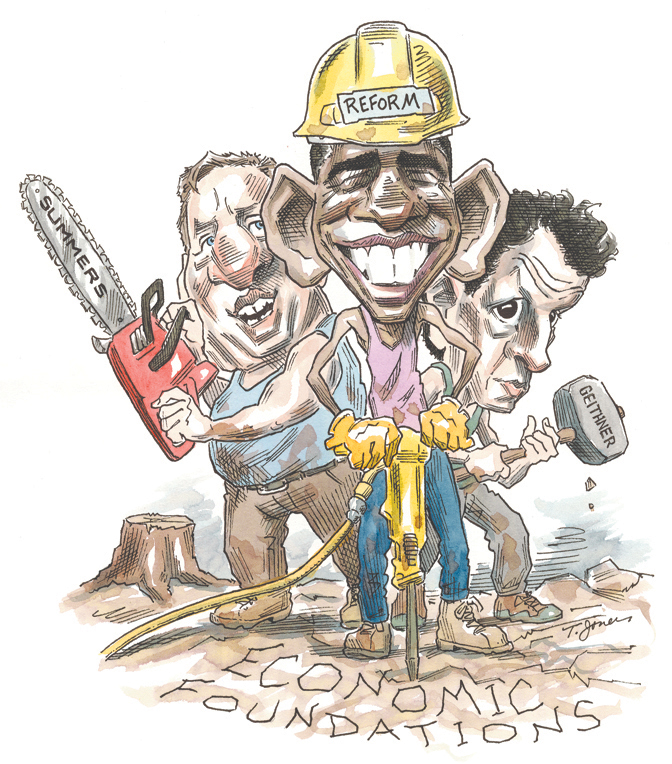
The efforts to transform the economy began with a fiscal stimulus package of nearly $800 billion. While some elements served the package’s stated purpose and helped soften the recession’s impact, the overall package was not well designed to foster a speedy recovery or set the stage for long-term growth. Instead, the “stimulus” was oriented to sectors that liberal Democrats believe deserve much greater federal help, which explains why much of the stimulus money was aimed toward education, health, energy conservation, and other activities that would do little to soak up unemployed resources or stimulate the economy.
Other government proposals created greater uncertainty and risk for businesses and investors, further discouraging a rapid recovery. These included plans to greatly increase marginal tax rates for higher incomes. In addition, discussions at the Copenhagen climate conference and by the president about imposing high taxes on carbon dioxide emissions must surely discourage investments in refineries, power plants, factories, and other businesses that emit greenhouse gases.
Small businesses are worried about the major new changes in the American health delivery system. They fear that their labor costs will increase because of mandates to spend much more on health insurance for their employees. The resulting reluctance of small businesses to invest, expand, and hire harms households as well because it slows the creation of new jobs and the growth of labor incomes.
A BROAD CLIMATE OF UNCERTAINTY
The administration also indicated early on that it would take a different approach to antitrust policy, reversing a thirty-year trend toward more consumer-based interpretations of antitrust laws. Likewise, the installation of a pay “czar” in Washington is worrisome, even though his activities have so far been confined to companies that received substantial bailout assistance from the government. Perhaps Congress, as a next step, will decide that executive pay is too high generally and levy special taxes on bonuses or impose other controls over executive compensation, as the British and French have done. Congress is also considering major new regulations on consumer financial products.
In its efforts to combat the financial crisis and recession, the Fed created more than $1 trillion in excess reserves at banks through various bailout programs and open-market operations. When banks draw on these reserves for loans to businesses and households, there is a potential for the money supply to grow rapidly, possibly producing substantial inflation. How hard the Fed will fight inflationary pressures through open-market sales and other actions that raise interest rates creates uncertainty over whether future inflation and potential monetary-policy tightening might choke off the recovery.
Uncertainty about monetary policy has important political dimensions as well. The Fed now faces greater political pressures than at any other time in the past quarter century, as demonstrated by the grilling the Senate banking committee gave Fed Chairman Ben Bernanke when considering his reappointment. These pressures may intensify when future Fed actions to restrain inflation clash with politicians’ desires to prop up housing and the major government enterprises enmeshed in housing finance.
Even though some of the proposed antibusiness policies might never be implemented, they generate considerable uncertainty for businesses and households. In a highly uncertain policy environment, the prudent course is to set aside or delay costly commitments that are hard to reverse. The result is reluctance by banks to increase lending—despite their huge excess reserves—reluctance by businesses to undertake new capital expenditures or expand workforces, and reluctance by households to make major purchases.
The data point to extreme caution by businesses and households. A regular survey by the National Federation of Independent Businesses (NFIB) shows that recent capital expenditures and near-term plans for new capital investments remain stuck at thirty-five-year lows. The same survey reveals that only 7 percent of small businesses see the next few months as a good time to expand. Only 8 percent of small businesses report job openings, as compared to 14–24 percent in 2008, depending on the month, and 19–26 percent in 2007.
HOBBLED BY POLITICS AS WELL
The weak economy is by far the most prevalent reason given for why the next few months is “not a good time” to expand, but “political climate” is the next most frequently cited, well ahead of borrowing costs and financing availability. The authors of the December 2009 NFIB report on small-business economic trends state that “the other major concern is the level of uncertainty being created by government, the usual source of uncertainty for the economy. The ‘turbulence’ created when Congress is in session is often debilitating, this year being one of the worst. . . . There is not much to look forward to here.”
Government statistics tell a similar story. Business investment in the third quarter of 2009 was down 20 percent from the low level of a year earlier. Job openings were at the lowest level since the government began measuring them in 2000. The pace of job creation by expanding businesses is slower than at any time in the past two decades and, although older data are not as reliable, probably slower than at any time in the past half century. Although layoffs and new claims for unemployment benefits have declined in recent months, job prospects for unemployed workers continue to be bleak. The exit rate from unemployment is lower now than at any other time on record, dating back to 1967.
According to the Michigan Survey of Consumers, 37 percent of households plan to postpone purchases because of uncertainty about jobs and income, a figure that has not budged since the second quarter of 2009 and that remains higher than in any previous year back to 1960.
These facts suggest that it was a serious economic mistake to press for a hasty, major transformation of the U.S. economy on the heels of the worst financial crisis in decades. A more effective approach would have been to concentrate first on fighting the recession and laying solid foundations for growth. Congress and the president should have put plans to re-engineer the economy on the back burner and kept them there until the economy had fully emerged from the recession and returned to robust growth. By failing to adopt a measured approach to economic policy, political leaders may be slowing the economic recovery and thereby prolonging the distress from the recession.








